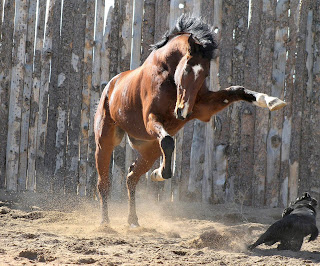This exercise is one that works incredibly well for getting horses to use their haunches, sitting and rocking back on their hind end to create a really powerful spring over the jumps. I also find it makes sluggish horses much more responsive to forward cues while jumping. Highboy is full of nonsense and can be very hot and silly, but one of the things he struggles with is FORWARD. He has a long history of prancing sideways and up and down, but forward motion is not an automatic thing for him.
For example:
But the shenanigans are not limited to messing around in the round pen at liberty - he also has some impressive sideways and vertical maneuvers under saddle.
This ride was no exception, he always has to express that he's full of beans in the warmup.
This continues until we are walking over a jump that is the height of the standards. As the jump grows larger, the horse has to rock back on his haunches more, becoming more powerful as well as light in his front end, so that he can spring over the progressively larger jumps from the same speed out of the walk. I know the exercise has been a success when I can feel the horse coil up underneath me like a cat ready to pounce.
Because Highboy loves jumping, even on his own with no rider, I knew he would like this exercise. Sure enough, by the end I had him walking over not just the blue jump where I established the exercise, but also walking over the 3'6" oxer and the 3'6" vertical in other places in the arena.
It was great fun to look through these photos and see the concentration in Highboy's face when he was really thinking hard about how to jump such a large fence out of the walk.
While we were occupied with this in the arena, the new pony was watching from the other side of the fence.
I've started calling him Walsh, because the leather halter I have that fits him has "Walsh" engraved on the buckle. It's probably an old brand (it's an old halter that was given to me), but the pony doesn't seem to care what I call him as long as I say it in a nice voice. So Walsh it is.
He wanted to come out to ride next, so after Highboy was cooled out I tacked up little Walsh.
We did a quick warm up, just to show Sara, Alice, and Kim H. how nice his gaits are and how great his dressage is coming along. Then we began over the same exercise he had just watched Highboy do. This 13 hand pony sure has hops! The incredible bay jumping pony begs the question, did Highboy shrink in the wash? Or did Highboy shrink into Walsh?? (My working student is the queen of pun-ny humor and will appreciate that.)
It is actually MUCH more difficult for me to ride a small horse like Walsh than it is to ride a large horse like Highboy. On a small pony my weight is a much more significant fraction of his weight, so I need to stay absolutely balanced in the saddle. Because there is not much real estate beneath me, there is literally very little room for error. Small horses are quick to turn and move, necessitating my balance be really spot-on for a successful ride. I use a visual where I imagine myself as a lego person, tiny, compact, and sitting immediately behind myself. This helps me to get my center of gravity lower and move with quick small movements of a pony. Fortunately, despite Walsh's small size he does carry me well and is balanced and strong enough to handle me over fences.
If I get off balance, it throws us both off balance and makes it extremely difficult for the pony to do his job. Here is a perfect example of me getting ahead of him (which is extremely easy to do when you're atop such a petite mount!) which messed up his balance and made him stop just as he should have been taking off. I could hardly punish him when I knew it had been my fault, and here at Bit of Honey mistakes don't earn you punishment, they just get you another try. We proceeded to try again, and he did really well, jumping this fence that was quite large for him, out of the walk. Or out of the catwalk as it feels when you're aboard!
The stopping photo does make me think he could be a reining pony, too, though. Sliding stops? No problem!
One more interesting photo I want to share is this one of Highboy on landing. Notice where his feet meet the ground, and how much hyperextension there is in his fetlocks (where the arrows point). This is an example of why you want your horse very sound to do this type of work. During takeoff tt strains the body, you can check out any of the horse's butt muscles to see how hard the hind end works. On landing jumping also greatly strains the front legs especially the lower joints. This is why I wait to start horses jumping until they are close to fully grown, usually ages six to seven. I'll do lots of ground poles and walking over small cross rails with them when they are younger to give them the idea, but I don't pound on their bodies with bigger fences until they are physically able to do it. I also am careful to give them plenty of rest days between jumping sessions so their bodies can recover and grow stronger.
Miles, my assistant coach the border collie, agrees with this philosophy. He was there helping us all day with the exercises, barking encouragement whenever needed.



























No comments:
Post a Comment